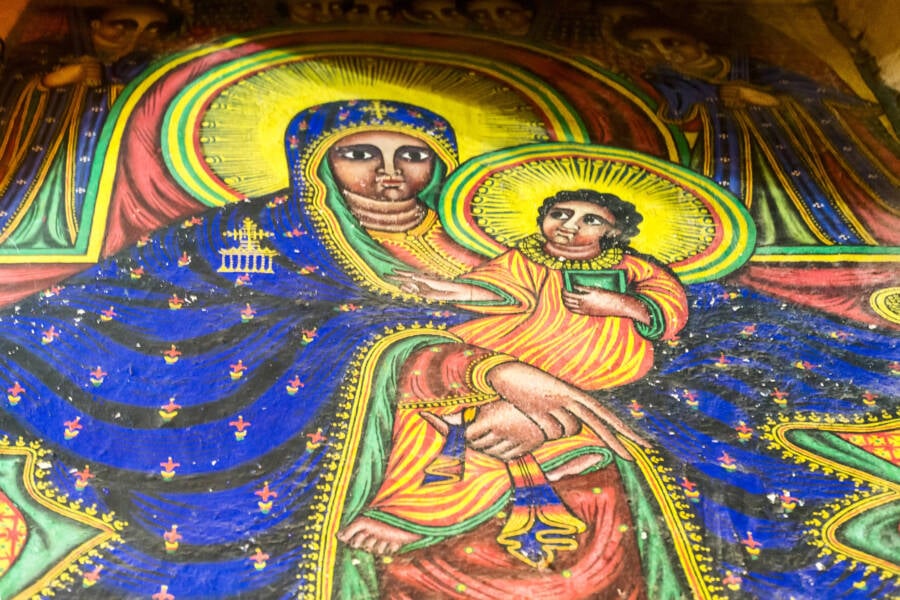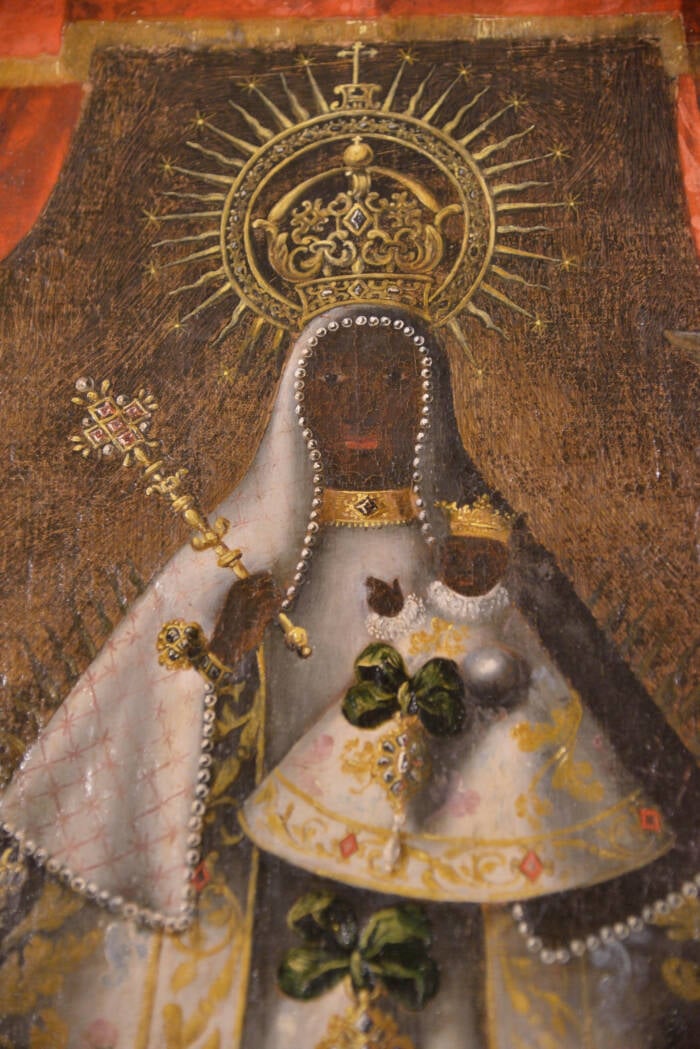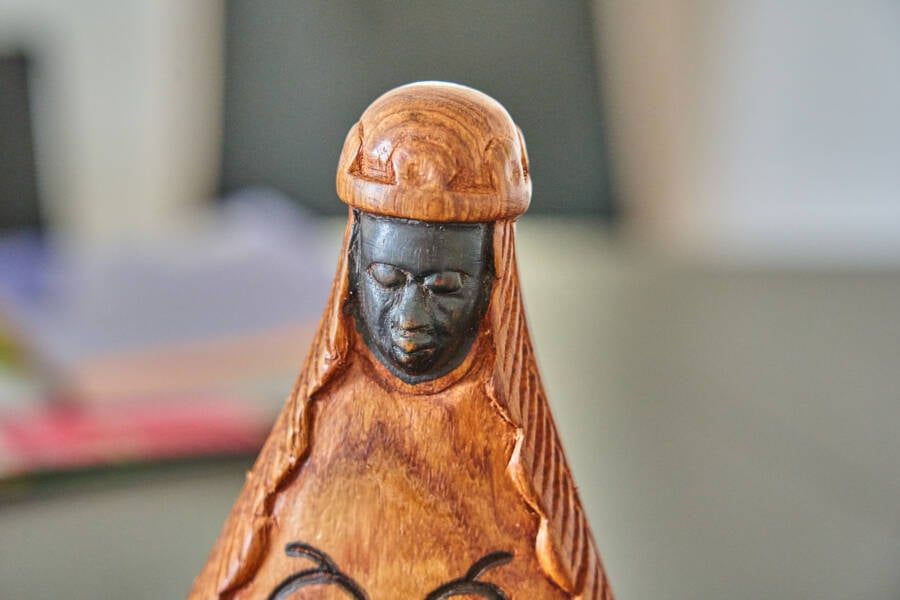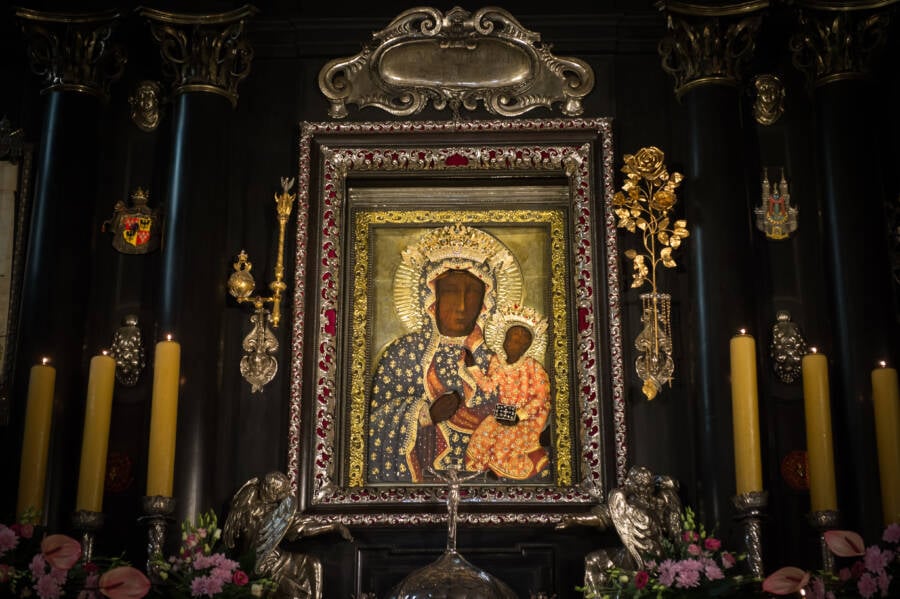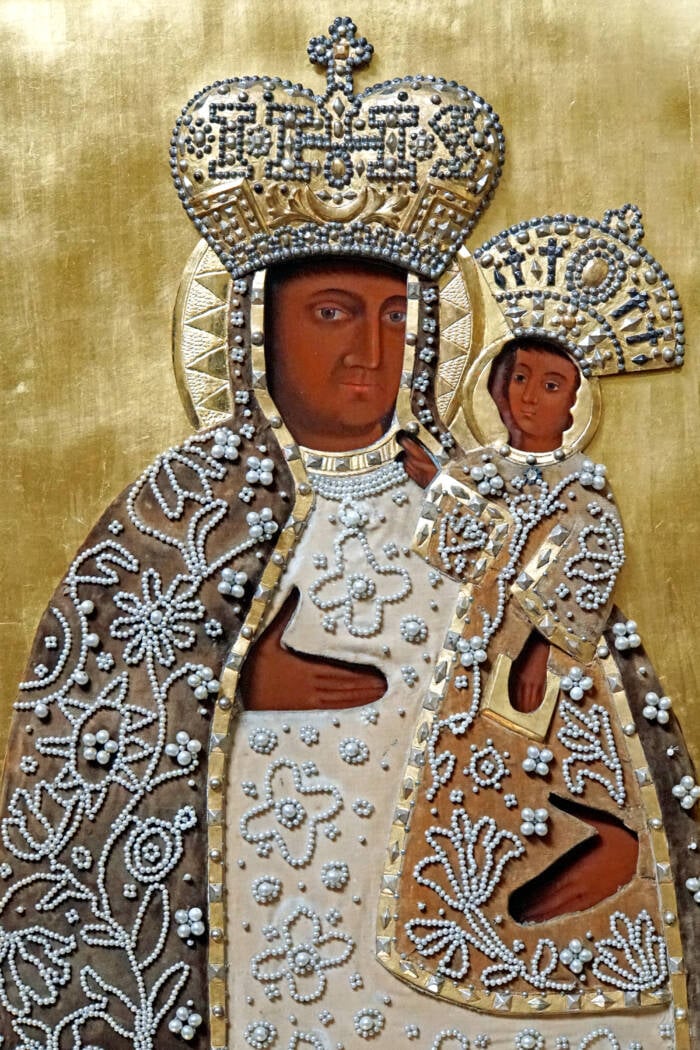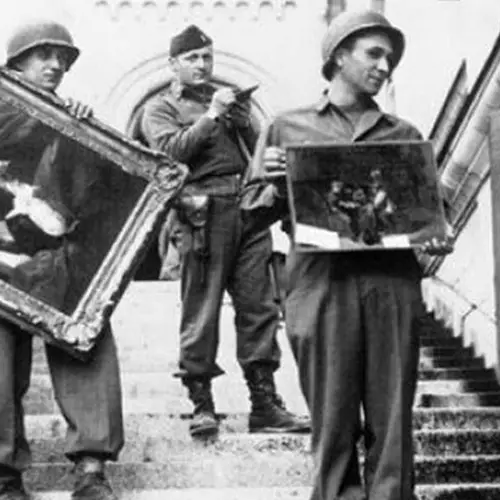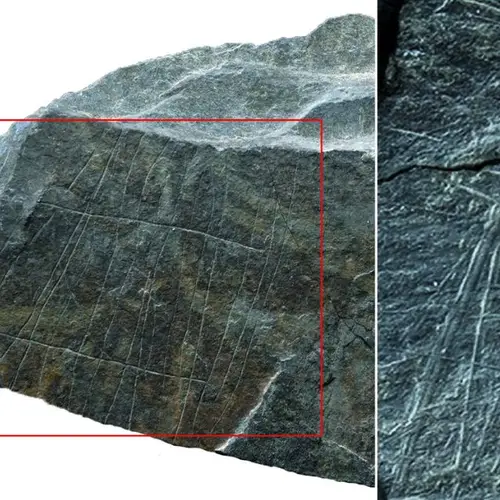While some think medieval artists used materials that naturally darkened over time — or simply repurposed old pagan artworks — others believe the Black Madonna's skin tone was completely intentional.
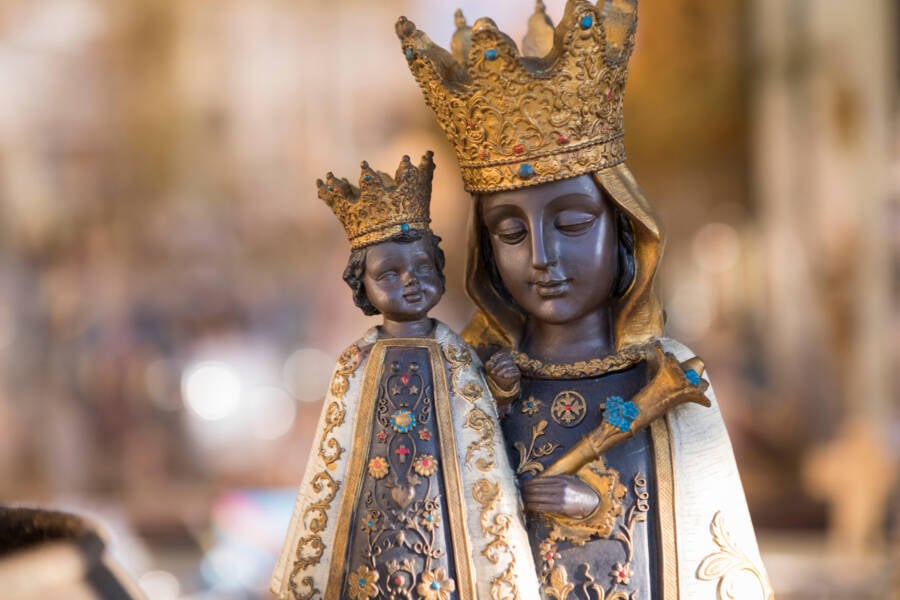
Ger Beekes/Alamy Stock PhotoA depiction of the Black Madonna holding baby Jesus.
In most Christian churches across the West, the Virgin Mary is portrayed with light skin, much like her son Jesus Christ. But an estimated 400 to 500 versions of the Madonna portray her with dark skin — and, surprisingly, many of these “Black Madonnas” are found across Europe.
These depictions often include both a dark-skinned Virgin Mary and a dark-skinned baby Jesus, and they can be found in various churches, museums, and shrines. Most of these artworks seem to date back to the medieval era, but their exact origin stories are often shrouded in mystery.
Some theories suggest that Christian artists simply repurposed old pagan artworks that depicted pre-Christian deities and spiritual figures, who happened to have dark skin. Others claim that Christian artists used certain materials in their pieces that just happened to darken over time.
And yet other researchers argue that the dark skin of the Black Madonna was a conscious — yet symbolic — choice linked to Biblical references and cultural associations with fertility, motherhood, and the Earth.
In the cases where the dark hue was intentional, most of these artworks from Europe were likely meant to be metaphorical representations instead of a literal interpretation of the Virgin Mary’s appearance.
However, it’s also worth noting that in recent years, some African and Black American artists have included more explicit African features in their depictions of Mary, highlighting her universal importance to Christians all over the world. Black Madonnas have also emerged in South America and Asia, further emphasizing the widespread influence of these artworks.
The Mysterious Origins Of The Black Madonna
It's difficult to say exactly how many Black Madonnas there are in the world, but it's been estimated that there are roughly 400 to 500 — most of which are located in Europe. These illustrations and statues usually show both the Virgin Mary and baby Jesus with varying shades of dark skin.
Author Christena Cleveland, who has studied these artworks extensively, notes, "Only a small percentage of the 450 Black Madonnas in the world look explicitly Black or have what we would call African features. Many of them have black skin combined with more Eurocentric features."
They are often found in mediums like paintings and wooden sculptures, appearing in standing and sitting positions. They have been viewed — and revered — in numerous museums, churches, and shrines around the world. However, the origins of their dark hue are very much debated.
One theory is that artists used dark materials — like certain types of wood — to create the art pieces, perhaps to represent the ancient history of the Holy Land. Or, they could have used materials that gradually darkened.
Another theory is that these art pieces emerged due to pre-Christian artistic traditions, since some pagan sculptures showcased deities with dark skin. It's possible that with the rise of Christianity, artists simply replaced existing pagan subjects with the Virgin Mary and her son, perhaps by superimposing representations of mother and son on top of existing statues.
However, some researchers speculate that there may be a different intent behind the Black Madonna. Some think that the dark skin may have been a conscious choice, in light of Biblical passages like Song of Songs 1:5:
Dark am I, yet lovely,
daughters of Jerusalem,
dark like the tents of Kedar,
like the tent curtains of Solomon.
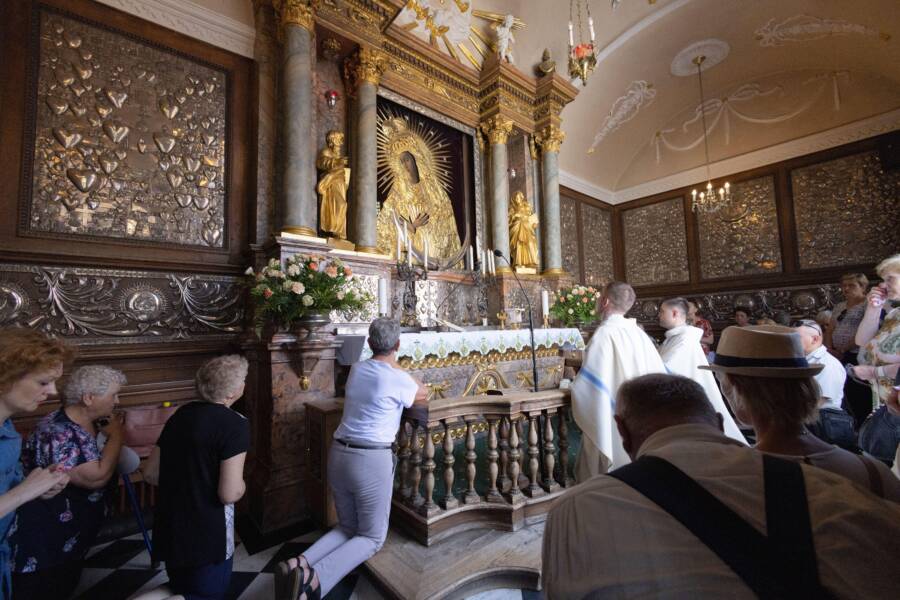
Imagedoc/Alamy Stock PhotoWorshipers at the Chapel of the Gate of Dawn in Vilnius, Lithuania.
Furthermore, in certain pre-Christian groups, dark skin was also associated with fertility and motherhood, since darker hues were closer to the shade of the Earth's soil. This may have influenced later Christian artists who wanted to emphasize the Virgin Mary's legacy as the devoted mother of Jesus.
"The best fertile soil is black in color and the blacker it is, the more suited it is for agriculture," the University of Dayton explained.
Indeed, many experts do not believe that the Black Madonna represented European artists' understanding of the Virgin Mary and Jesus' actual physical appearance. In the cases where the dark coloring was intentional, it probably served more of a metaphorical and spiritual purpose.
Regardless of its origins, the Black Madonna is widely seen as a miraculous figure capable of providing Christian viewers with a stronger connection to their religion. Oftentimes, visitors travel great distances to view famous Black Madonnas, including Our Lady of Częstochowa in Poland.
"We mustn't forget that the World Youth Day, which took place in Częstochowa 25 years ago, was the first with youth who came from the countries of the east. There were around 200,000, coming from Ukraine, from Russia, and Belarus," Cardinal Stanisalw Dziwisz, Archbishop of Krakow, explained to the Catholic News Agency in 2016.
Other famous depictions of the Black Madonna include Our Lady of Montserrat in Spain, Our Lady of the Hermits in Switzerland, and Our Lady of Altötting in Germany. Outside of Europe, the dark-skinned religious figure can also be found in Africa, South America, and Asia. With such widespread influence, it is clear that the history of these artworks is rich and complex.
The Murky History Of The Dark-Skinned Virgin Mary And Her Infant Son
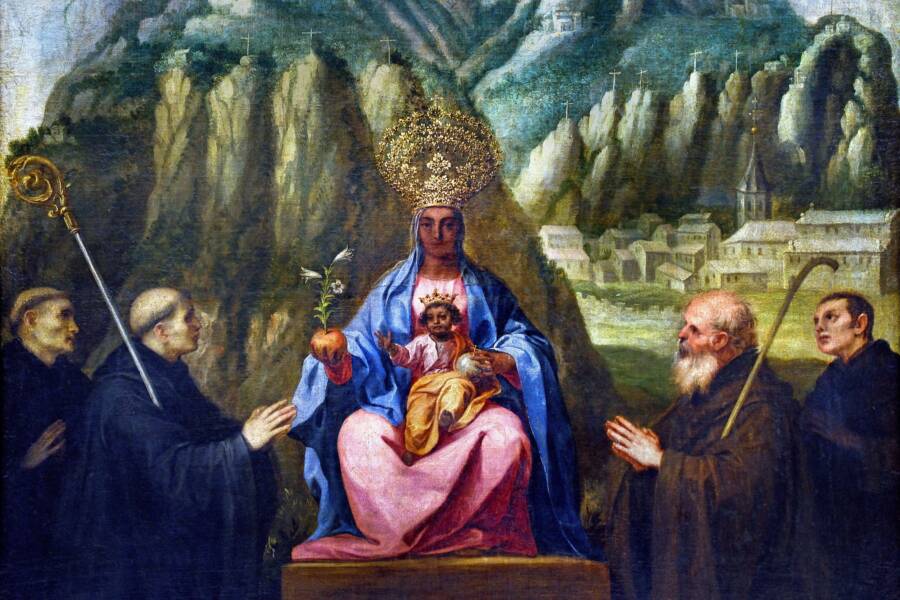
Peter Horree/Alamy Stock PhotoThe 17th-century Virgin of Montserrat by Alonso Cano.
The exact history of the Black Madonna is as mysterious as its composition. Most Black Madonnas from Europe appear to date back to the medieval period, particularly the 11th century to the 15th century.
However, some of these artworks are rumored to be much older. For example, some Christians believe that the famous Our Lady of Częstochowa image dates all the way back to the time of the Twelve Apostles.
A number of these images have also had a somewhat perilous history, with the original Notre-Dame de Sous-Terre in France (believed to date back to the 11th or 12th century, or possibly even earlier) being burned during the French Revolution and then later replaced with new replicas.
But it's believed that the Black Madonnas first began rising in popularity in Europe during the 11th and 12th centuries, likely due to the outlawing of pagan icons. This ties into the theory that some pre-Christian sculptures were repurposed to avoid the complete destruction of existing artwork.
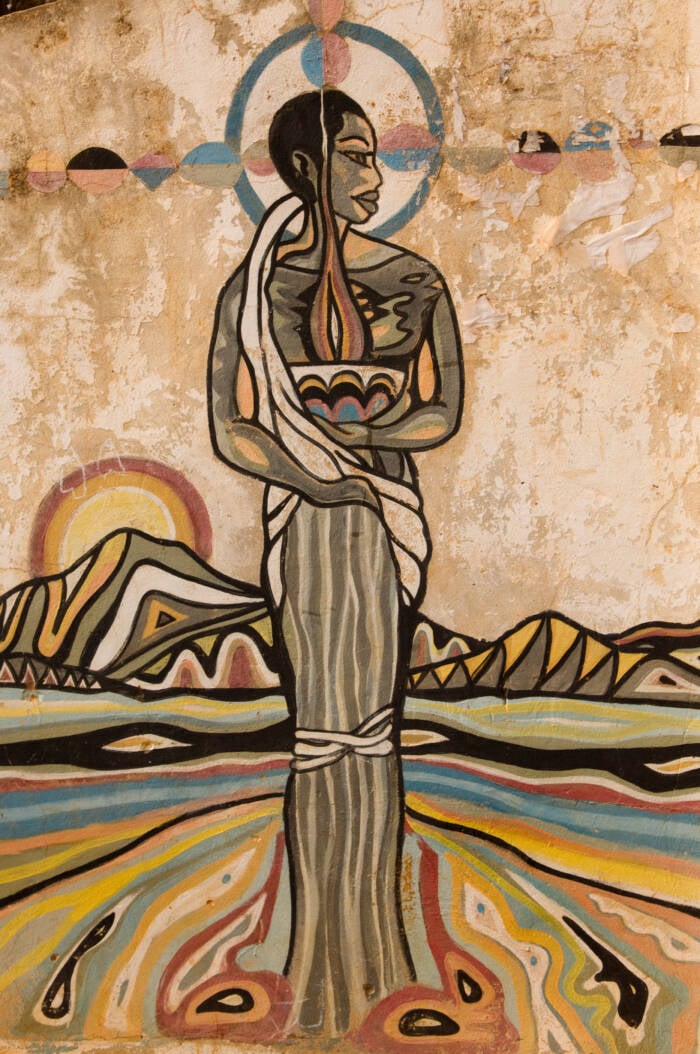
Ariadne Van Zandbergen/Alamy Stock PhotoA painting of the Virgin Mary in Petit Cote, Senegal.
Some art historians have postulated that the earliest Black Madonnas may have been recycled images of the Egyptian goddess Isis and her son Horus. Early Christians may have used these existing icons to create their own art pieces, pushing the timeline for their creation as far back as ancient times.
"The Black Madonna figures were often superimposed on earlier pre-Christian goddess cults in these formerly Roman regions, especially the cult of Isis. Early churches were often built on sites of Roman temples and in fact some early Madonna figures were later replaced after it was discovered that they were actually statues of Isis and Horus," the Western Washington University has said about these early artworks.
While the full history may never be completely unraveled, these artworks remain a subject of fascination. And Black Madonnas are still being created in modern times, especially by African and Black American artists who offer their interpretation of the Virgin Mary and the birth of Jesus Christ. More attention is also being paid to older artworks in Africa that may have been created to honor Mary and Jesus during the early days of Christianity.
Overall, these figures are remarkable symbols of artistic and religious history that invite reflection on our cultural heritage, our beliefs, and our perceptions — and they hold an especially important meaning for Christians who travel great distances just to behold them in person.
After reading about the fascinating history of the Black Madonna, dive into the search for what Jesus Christ really looked like. Then, read about Pontius Pilate, the Roman governor who ordered Jesus' execution.
